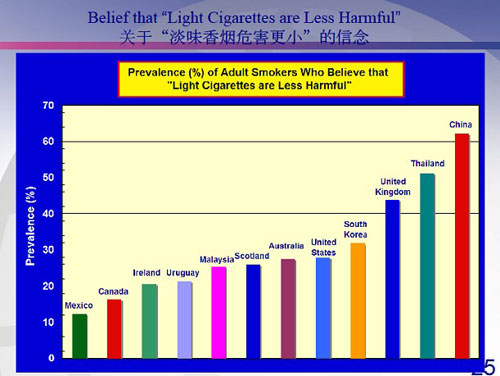Low-tar cigarettes a trap
A tobacco company is using a low-tar cigarette to attract young people. It causes tremendous harm like other types of cigarettes. One method used by the World Health Organization (WHO) to combat smoking is the MPOWER principle.
What are low-tar cigarettes?
"A little lower means more loving care."
"Low-harm cigarettes give you more loving care."
"…the world's most advanced low-harm cigarette technology, offering a guarantee of health for your life."
 |
In China, more than 60 percent of people polled believe that low-tar cigarettes mean they're less harmful – this was the highest percentage of all the countries polled. Supported by the Campaign for Tobacco-Free Kids, the All-China Environment Federation hosted a two-day training camp for journalists and NGO workers on November 3 and 4. During the camp, many domestic and international experts presented statistics of the dangers of smoking, provided inside stories of tobacco companies, and painted an austere picture of China's current smoking situation. The All-China Environment Federation is a NGO that is trying to prevent smoking habits from developing.

"Now there are more than 1 billion smokers in the world, and more than 0.35 billion of them are Chinese, accounting for one-third of the total. Moreover, more than 1 million people have died from various kinds of tobacco-related diseases," said Yang Jie, director of the Chinese Center for Disease Control and Prevention. According to the World Health Organization's 2008 estimation, more than one-third of men will die due to tobacco-related diseases, and half of them will die before turning 65 years old.
We know that smoking results in many lethal diseases, such as lung cancer, laryngocarcinoma, asthma, etc. However, most people don't understand the harm low-tar cigarettes can cause.
Low-tar cigarettes are cigarettes with holes punched in the filter, which allows air to dilute the smoke and therefore feel smoother on the smoker's throat and chest. This also allows the smoker to alter the nicotine dose by covering the holes and therefore getting more tar.
"Filters rest outside the Federal Trade Commission (FTC) and International Smoking Organization (ISO) testing machines, so by not blocking the filter vents, tar levels get reported lower than they actually are," said Jiang Yuan, deputy chief of the Tobacco Control Office at the China CDC. Jiang noted that, "Epidemiological evidence shows that 'light' or 'low-tar' cigarettes are just as harmful."
 0 Comments
0 Comments






